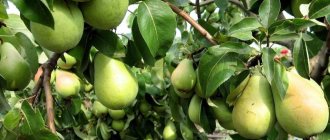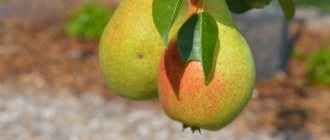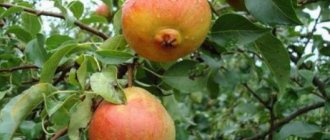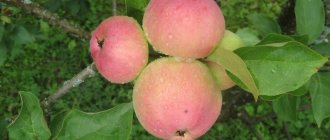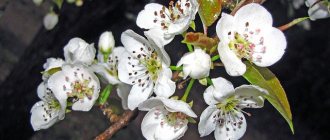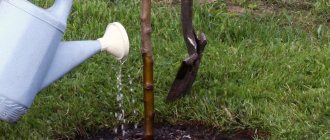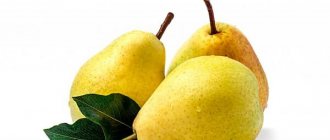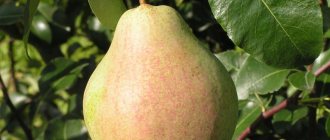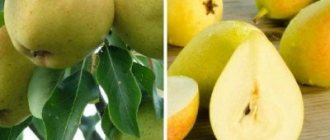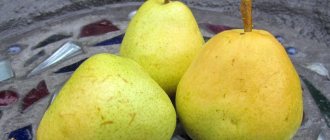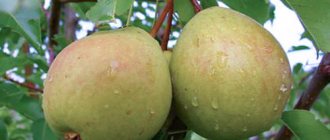Kyrgyz winter pear is a winter early-fruiting variety, invaluable for regions with difficult climatic conditions. This hardy plant easily adapts to the local climate, and its fruits are of high commercial quality.
The variety is frost-resistant and immune to scab
The Kyrgyz winter pear has ovoid or lemon-shaped fruits
Description and characteristics of the Kyrgyz winter pear
This winter variety is ready for harvest only in the first ten days of October. Pears, when ripe, do not fall and remain firmly on the branches.
Description of the variety:
- Tree. A medium-sized tree has a dense, pyramidal-shaped crown. The crown lends itself perfectly to planar formation. Fruit formations are located mainly in ringlets.
- Fruit. Pears are shaped like eggs or lemons. When picked they are green-yellow, and when fully ripe they are golden-yellow. On the sides there is a red-carmine blush, thanks to which the fruits have an aesthetically attractive, elegant appearance. The creamy, yellowish pulp has a dense, coarse-grained structure. The taste is sweet, slightly tart.
The main characteristics of the Kyrgyz Winter variety are in Table 1.
Table 1
| Characteristics | Options |
| Productivity, c/ha | 500-600 |
| Precociousness | 3-4 years after landing |
| Fruit weight, g | 220-250 |
| Disease resistance | scab, thermal burns, powdery mildew and bacterial cancer |
| Transportability | good |
| Winter hardiness | high |
| Suitable pollinators | Emerald, Talgar beauty, Golden, Zest of Crimea |
Description and varietal characteristics
Pear trees of the “Kirgiz Winter” variety are of medium vigor. They form a sparse, pyramidal crown. This variety is characterized by the location of fruit formations on the ringlets. The fruits do not fall off the branches during the process of filling and ripening.
The fruits are attractive, large in size, one-dimensional. The average weight of the fruit can reach 225-245 g. The fruits are oblong, covered with green-yellow skin, which at the stage of full ripening acquires a beautiful golden-yellow color with a bright reddish-carmine blush over almost the entire surface.
The pulp is cream-colored, with a slight yellowish tint. The consistency of the ripe pulp is dense, with coarse grains and a tart, pleasant taste. The fruits are characterized as transportable and very shelf-stable. They are perfectly preserved in a regular household refrigerator until the first ten days of April.
How to choose the right seedling?
It is recommended to buy seedlings for planting in fruit tree nurseries or in stores specializing in the sale of planting materials.
In order for a healthy, full-fledged tree to grow in the garden in a few years, you need to buy healthy, high-quality seedlings. When choosing them, pay attention to:
- External characteristics - the seedling must be absolutely fresh, without the slightest sign of lethargy.
- Product labeling - the seedling must have a label indicating the variety and growing zone.
- Root system - it should have 5 main and 3 additional roots. The minimum length of the roots is 30 cm, the roots must be light, not rotten and without growths.
- Age – seedlings 2 years old are considered the best option.
Landing
Since planting the Kyrgyz pear must be done strictly vertically, two people must be involved in the process.
First, the main roots are cut off with pruning shears and immersed in liquid clay mash for several minutes. During this time they will have time to become saturated with the composition.
A mound is formed in the center of the previously prepared hole, into which a seedling is placed on the north side of the peg. Then you need to evenly:
- distribute the roots;
- point them down;
- fill the free space with soil;
- compact it carefully.
Preparation and planting
In order to create optimal conditions for development and fruiting for the Kyrgyz winter pear, it is necessary to follow agricultural practices at every stage of the tree’s life. And you need to start with the correct selection and preparation of the site.
Choosing a landing site
Requirements for a site for planting seedlings of the Kyrgyz winter pear:
- Good lighting. The variety is able to grow in semi-shaded places, but will not bear fruit.
- Elevation. The tree grows better in areas where the groundwater is deep enough - this will prevent rotting of the roots. The length of pear roots reaches 8 m, which is why it is recommended to grow it on slopes and hills.
- Soil with loam under the fertile layer. Pears do not grow well on sandy and heavy soils.
- Wind protection. It is desirable that there be a landing, a wall, or other barrier on the side of the prevailing winds.
- The recommended side for planting is west and southwest.
Before planting pears, check the soil for acidity, and if it exceeds the norm, liming is carried out.
Landing dates
There are two options for planting pear seedlings - in spring and autumn. The choice of planting time depends both on the personal preferences of the gardener and on objective factors.
In harsh climates, most gardeners choose spring to plant any fruit trees. In regions with short summers, winter comes so early that a seedling planted in the fall may simply not have time to take root before the onset of cold weather.
Benefits of spring planting:
- The planting hole is prepared in the fall, and when the time comes to plant the seedling, it is in an ideal condition for receiving a young tree.
- The soil is filled with moisture after the snow melts, which creates optimal comfort for the seedlings.
- During the spring-summer season, the young tree gains strength in preparation for wintering. During this time, the gardener has the opportunity to adjust the conditions of growth and development.
Recommended spring planting dates:
- in areas with risky farming, it is not recommended to plant anything before May;
- in the Volga region, seedlings are planted in the first half of April - before the onset of heat;
- in the middle zone - in the second half of April or in the first half of May.
The disadvantage of spring planting is that the seedling must simultaneously take root and begin the vegetative cycle. The choice of exact landing dates depends on the specific characteristics of the region.
Autumn planting is practiced in the southern regions, where warm autumn is replaced by a mild winter. The advantage of autumn planting over spring planting in warm regions is that it eliminates the risk of seedlings that have not had time to take root burning out.
Autumn planting dates:
- in the southern regions - the first half of October;
- in the Moscow region - the second half of September - early October;
- in regions with more extreme climates - until October.
If you received seedlings in late autumn, it is better to save them until spring. To do this, they dig a trench, place seedlings in it - at an angle, cover it with earth, then peat, fallen leaves and cover it with a non-woven cloth. In such a shelter, the seedlings will survive the most severe frosts, and in the spring they are transplanted to a permanent place.
Site preparation
In order for the seedlings to quickly take root in a new place, they are provided with the most comfortable conditions. Stages of site preparation:
- Pit. If there is an autumn planting, the pit is prepared a month before planting the seedling, if it is spring, the pit is prepared in the fall. The depth of the hole takes into account the age of the seedlings. For one-year-olds, they dig a hole 0.5 m deep, for two-year-olds - 0.7 m. The diameter of the hole is selected taking into account the spreading roots - they should be comfortable in the hole.
- Support. The seedling needs reliable support that will protect it from the sun - it is not for nothing that it is placed on the south side, and from the winds. A wooden peg serves as a support. Its height from ground level is 0.5 m.
- Fertilizers. Superphosphate and ammonium nitrate are poured into the bottom of the pit. Total - 2 kg, if granular fertilizers - 1 kg. 10 kg of organic fertilizers are applied. If the soil is sandy, add 1/2 a bucket of peat. Fertile soil is poured over the fertilizers - the roots of the seedling should not come into contact with the fertilizers.
You cannot apply more fertilizer than normal so as not to burn the roots of the seedling. As a result of the burn, the young tree may die.
Step-by-step landing instructions
It is better to plant seedlings with an assistant. It is necessary to hold the tree strictly vertically during manipulations - this is why a second person is needed.
Step-by-step planting of a pear:
- Having cut off the main roots with pruning shears, they are immersed in liquid clay mash. For the roots to become saturated with the solution, just hold them there for a few minutes.
- A mound is made in the center of the hole, and a seedling is placed in it - on the north side of the support.
- Distribute the roots evenly over the soil mound. The roots should not bend or break, they should be directed downwards.
- The roots are covered with soil and carefully compacted. When adding soil, the seedling is shaken each time - without changing its vertical position. Shaking allows you to eliminate voids between the roots. The grafting point should be located 4 cm above the ground.
- The planted seedling is watered. Water is poured so much that the soil is completely saturated. As the tree becomes moist, it sinks - the root collar is flush with the soil.
- The seedling is pruned to 80 cm to form a crown on a well-ripened bud. Processes present at a height of up to 50 cm are removed.
- The seedling is tied to a support - soft and durable material. Mulch is poured into the tree trunk circle - it will help retain moisture in the soil.
Preparing for landing
In order for the seedlings to take root well, you need to carefully prepare for planting, creating comfortable conditions for the trees.
First, dig a hole, the depth of which is determined taking into account the age of the seedling:
- For annuals, a depth of 0.5 m is suitable;
- two years old - 0.7 m.
As for the diameter, it is determined by the size of the root system. She should have as much space as possible in the pit.
Support
The tree requires good support that will protect the crop from the sun and wind. To do this, a wooden peg 0.5 m high from the ground surface is installed on the south side of the hole.
Fertilizers
Before planting, fertilize using:
You will need 2 kg of the composition (1 kg in the case of granular contents). 10 kg of organic fertilizers are also added. For sandy soil, add an additional ½ kg of peat. It is important to carefully measure the amount of fertilizer so as not to burn the roots. This is fraught with the death of the seedling.
The top dressing is covered with fertile soil so that the root system does not touch the top dressing layer.
Tree care
In order for the Kyrgyz winter pear to please its owners with abundant harvests, it is necessary to carry out a complex of seasonal work in a timely manner:
- care for the soil;
- apply fertilizers;
- form the crown and carry out sanitary pruning;
- spray the tree with insecticides and fungicides, carry out a set of preventive measures;
- prepare trees for winter.
Soil care
Simple agrotechnical measures can significantly affect the quality of life of a tree. As part of caring for the soil, the following work is recommended:
- Loosening. In the morning, after watering, the soil is loosened so that oxygen reaches the roots. Simultaneously with loosening, weeds are removed from the tree trunk circle.
- Mulching. To delay the evaporation of moisture, the soil around the trunk is mulched. Suitable mulch is sawdust, peat. Layer thickness – up to 10 cm.
Features of feeding the Kyrgyz winter pear
You cannot expect large harvests of pears without fertilizing. The lack of at least one vital element - potassium, nitrogen, phosphorus - immediately affects the well-being of the tree.
Signs of nutritional deficiencies:
- Potassium – low growth of shoots per year.
- Nitrogen – yellowing of leaves, shedding of fruits, cessation of tree growth.
- Phosphorus – inactive formation of fruit buds and, as a result, the absence of fruits.
Young trees only need nitrogen fertilizers, and seedlings are not fed at all for two years after planting.
70% of the total annual volume of fertilizers is applied in the spring. The time and rates for applying fertilizer to a pear tree are in Table 2.
table 2
| Fertilizer application time | Fertilizer | Note |
| Spring, swelling of the buds | Urea/saltpeter/chicken droppings. | To improve root nutrition. Urea – 30 g per 1 sq. m, dissolve 1:50. Saltpeter is diluted - 600 g per 10 liters. The litter is diluted 1:20. |
| Spring, after flowering | Mineral fertilizer “Nitroammofoska” (nitrogen+phosphorus+potassium). | To speed up the growing season (60 g per 3 buckets). |
| Summer | At the end of June, foliar treatment with nitrogen-containing fertilizers, a month later - repeat, after 2 weeks - application of phosphorus-potassium additives. | To improve the quality of fruits. |
| Autumn | In the first half of September - spraying with urea solution, applying liquid mineral fertilizers, fertilizing with ash. | An example of a solution is potassium chloride (1 tbsp), superphosphate (2 tbsp). The ash application rate is 130 g per 1 sq. m. |
Fertilizer rates for feeding pears, taking into account the age of the tree, are in Table 3.
Table 3
| Tree age | Organic, kg | Nitrogen, g | Phosphorus, g | Potassium, g |
| Young, before fruiting | — | 6 | — | — |
| Young, beginning to bear fruit | 1 | 9 | 6 | 9 |
| Mature, full fruiting | 1,5 | 12 | 9 | 12 |
| Adult, in years with a rich harvest | 2 | 15 | 12 | 15 |
Pear
On the territory of great Kyrgyzstan, a unique variety of winter-hardy pear was developed, called Kyrgyz. The starting material for its production was two varieties - Lesnaya Krasavitsa and Winter Coast.
A new type of fruit tree grows calmly and delights with a bountiful harvest even where unfavorable weather conditions prevail. It is for those who live in such places that this winter variety of crop is intended, the photo and description of which I will describe in more detail.
Pit
First, dig a hole, the depth of which is determined taking into account the age of the seedling:
- For annuals, a depth of 0.5 m is suitable;
- two years old - 0.7 m.
As for the diameter, it is determined by the size of the root system. She should have as much space as possible in the pit.
Support
The tree requires good support that will protect the crop from the sun and wind. To do this, a wooden peg 0.5 m high from the ground surface is installed on the south side of the hole.
Fertilizers
Before planting, fertilize using:
- superphosphate;
- ammonium nitrate.
You will need 2 kg of the composition (1 kg in the case of granular contents). 10 kg of organic fertilizers are also added. For sandy soil, add an additional ½ kg of peat. It is important to carefully measure the amount of fertilizer so as not to burn the roots. This is fraught with the death of the seedling.
The top dressing is covered with fertile soil so that the root system does not touch the top dressing layer.
Landing
Since planting the Kyrgyz pear must be done strictly vertically, two people must be involved in the process.
First, the main roots are cut off with pruning shears and immersed in liquid clay mash for several minutes. During this time they will have time to become saturated with the composition.
A mound is formed in the center of the previously prepared hole, into which a seedling is placed on the north side of the peg. Then you need to evenly:
- distribute the roots;
- point them down;
- fill the free space with soil;
- compact it carefully.
During the process, the seedling is periodically shaken, thanks to which the voids between the roots disappear. In this case, you need to ensure that the root collar is located 4 cm above the surface of the earth.
After planting, the seedling must be watered so that the soil is completely saturated. The tree will eventually sink a little, and the root collar will be level with the ground.
To form a root on a mature bud, the crop is cut to 80 cm. At a height of up to 50 cm, existing shoots are removed. Then the seedling is tied to a support with soft, durable material, and the tree trunk circle is mulched. This will help retain moisture in the ground.
Lighting
The Kyrgyz pear bears fruit well only where there is a lot of light. Partial shade is also acceptable for it, but in this case you may not expect a harvest.
Watering
After planting, watering the tree is not required for 10 days. Then watering is carried out once every 8-10 days, for this they use 15 liters per tree. Mature trees are watered once every 2 weeks, they need 30 liters. It is best to moisten the soil in the evening.
During the period when the fruits ripen, soil moisture is stopped, resuming it after harvesting.
Top dressing
Applying fertilizers when growing the Kyrgyz pear variety is a very important point. Without this, it will not be possible to achieve a harvest, because if there is a shortage of at least one of the vital elements - nitrogen, phosphorus. potassium - the tree’s health deteriorates sharply:
- shoot growth decreases throughout the year;
- the foliage turns yellow, the fruits fall off, the growth of the tree stops;
- Fruit buds are poorly formed and there is no harvest.
To avoid this, the crop needs regular feeding, 70% of which is applied in the spring. At this time, use urea, saltpeter or chicken droppings. After flowering, a mineral composition is added to speed up the growing season.
In summer, foliar treatment with fertilizers containing nitrogen is carried out. The first time - at the end of June, then a month later, after 2 weeks, a phosphorus-potassium mixture is added. This will improve the quality of the harvest.
When autumn comes, spraying is carried out using a urea solution, a liquid mineral composition, and ash.
Trimming
When growing this variety of pears, formative pruning is performed. This will create a pyramidal type of crown; it is most convenient for collecting fruits.
Annual sanitary pruning is also required, which is carried out in the spring. At that time:
- remove competing shoots;
- vertical branches that are directed inside the crown;
- damaged shoots.
In the total mass, 1/3 of the annual growth of branches is removed.
Before the onset of cold weather in the fall, you need to get rid of diseased, broken, dry branches. If the cut area is large, it is treated with garden varnish to prevent infection.
Wintering
For the wintering period, despite the winter hardiness and resistance to cold, it is necessary to insulate the trunk circle of the fruit tree. To do this, it is mulched using a composition that includes:
- peat;
- compost;
- humus;
- wood sawdust.
It is most important to do this if the plant is grown in the northwestern region.
The tree also needs to be tied with fabric up to 1 m in height, which will protect it from rodents. the material is pre-treated with a repellent mixture.
Brief conclusions
- The Kyrgyz winter pear is a fast-bearing tree. This variety allows you to get the first harvest 3-4 years after planting.
- The fruits collected in early October are distinguished by good keeping quality and transportability.
- For good growth and high yield of a crop, its seedlings need to be planted on slopes and hills, provided with plenty of light, timely watering and high-quality fertilizing.
- It is necessary to perform formative pruning to create a pyramid-shaped crown. This makes harvesting easier and makes the tree more attractive.
Source: https://sornyakov.net/frukty/grusha-kirgizskaya-zimnyaya.html
Spraying
The success of pest and disease control depends on the timeliness of treatment and the effectiveness of drugs. The first spraying is carried out in early spring - together with fertilizing carried out on the bare tree. If the buds on the tree are already swollen, then the urea solution can burn them, so it is recommended to use biological products - Akarin, Fitoverm and others.
Autumn spraying is aimed at combating larvae hiding in the soil and tree bark. The plant itself, as well as the soil adjacent to the trunk, is sprayed with Nitrophen and Bordeaux mixture 1%.
Table 4 shows the timing and preparations for spraying pears against pests.
Table 4
| Pests | Time of processing | Drugs |
| Honeyweed and aphids | in the spring, before the buds open | DNOC 40%, Nitrafen 40%U BI-58 |
| after the leaves appear | Metaphos, Fozalon | |
| Gall mite | during kidney swelling | Nitrafen |
| after flowering | Karbofos | |
| leaf roller | before buds open | Nitrafen |
| at the beginning of bud break | Fozalon, Chlorvos | |
| Multiflora pear | during a caterpillar invasion | Kemifosom, Fufanon, Karbofos |
| codling moth | a month after flowering | Karbofos, Decis |
Diseases that affect pear and other fruit trees can not only deprive their owners of their harvest, but also destroy the trees. To prevent diseases, preventative treatment of trees is used. Table 5 shows the timing and preparations for spraying pears against diseases.
Table 5
| Name | Diseases | How to cook? | When to use? |
| Bordeaux mixture 1% | scab, spotting, rust, moniliosis | for 10 liters of water – 200 g | before and after flowering, then at intervals of 10-15 days |
| Bordeaux mixture 3% | scab, spotting, moniliosis | for 1.7 liters of water – 100 g | before and during bud break |
| Urea | spotting, scab | for 10 liters of water – 700 g | before buds open |
| Copper sulfate | scab, spotting, moniliosis, drying out, phyllosticosis | for 10 liters of water – 100 g | before buds open |
| inkstone | fungus, lichens | for 10 liters of water – 500 g | before buds open |
| Gentamicin | bacterial burn | for 5 l – 1-2 tablets | in May-June |
| Colloidal sulfur | powdery mildew, scab | for 10 liters of water – 80 g | when symptoms of the disease appear (a total of 5 sprayings are carried out at intervals of 1-2 weeks) |
Watering
The seedling does not need watering for 10 days after planting in the ground. Features of watering pears:
- Seedlings are watered every 8-10 days.
- The water requirement for one young tree is 15 liters.
- Mature trees are watered every two weeks.
- The water requirement for an adult tree is 30 liters.
- Watering is stopped as soon as the fruits begin to ripen. Moistening is resumed only after harvesting.
- The best time to water fruit trees is evening.
As the pear tree ages, the number of waterings decreases, but the water rate increases - the older the trees, the more abundant the watering.
Features of care
It is not difficult to care for the crop; the main thing is to provide it with the necessary conditions for active growth and fruiting.
Lighting
The Kyrgyz pear bears fruit well only where there is a lot of light. Partial shade is also acceptable for it, but in this case you may not expect a harvest.
Watering
After planting, watering the tree is not required for 10 days. Then watering is carried out once every 8-10 days, for this they use 15 liters per tree. Mature trees are watered once every 2 weeks, they need 30 liters. It is best to moisten the soil in the evening.
During the period when the fruits ripen, soil moisture is stopped, resuming it after harvesting.
Tillage
It is important to keep the area around the trunk clean by regularly weeding out weeds. Loosening after watering will be useful, this will ensure the flow of oxygen to the root system.
This process is complemented by mulching, for which sawdust is used. They are poured in a layer 7-8 cm thick. This allows moisture to be retained.
Top dressing
Applying fertilizers when growing the Kyrgyz pear variety is a very important point. Without this, it will not be possible to achieve a harvest, because if there is a shortage of at least one of the vital elements - nitrogen, phosphorus. potassium - the tree’s health deteriorates sharply:
- shoot growth decreases throughout the year;
- the foliage turns yellow, the fruits fall off, the growth of the tree stops;
- Fruit buds are poorly formed and there is no harvest.
Pruning and crown formation
The most convenient type of crown for harvesting is pyramidal. To form a pyramid-shaped crown, it is necessary to prune the pear starting from the second year of life.
Principles of pruning a pear tree:
- Having determined which branches of the seedling will be skeletal, cut off all the others. This pruning is done immediately after planting. The main conductor is also cut to 1/4 of the length. Under the first tier, the shoots are removed.
- In the spring of the second year of life, the trunk is shortened by 20 cm. The skeletal branches are trimmed by 5 cm, no more. They are pulled back with twine so as to achieve a 60 degree fit to the trunk. Leave 2 shoots on the main branches for fruiting.
- Every year, in the spring - sanitary pruning. Competitor branches are deleted. Vertical branches directed into the crown that are damaged are trimmed. A third of the annual growth is removed.
- Every year, in the fall – pruning of dry, broken and diseased branches.
Sections of large areas must be treated with garden varnish to avoid infection.
When pruning a pear, use a stepladder, since the branches of the tree are fragile and can break under load.
Preparing for winter and protecting against rodents
Kyrgyz winter is a frost-resistant variety that does not require insulation. But the bark is a tasty dish for hares and rodents. To protect the tree from attacks by animals, its trunk is wrapped in fabric - up to 1 m in height. Before use, the fabric is impregnated with a repellent composition.
Young trees, unlike adults, are covered with spruce branches for the winter. Burlap is wrapped around the spruce branches. This will protect the young animals both from animals and from the cold. An earthen mound is built around the trunk, which is mulched by scattering straw or peat in a 15 cm layer. When snow falls, a snowdrift is formed near the trunk.
Harvesting, storage and transportability
Kyrgyz winter pear is a winter variety that has good shelf life and transportability. The fruit is harvested in early October. The picked fruits are green and hard; they will be ready for consumption only after 2-3 months. And they are stored for 6-8 months.
In order for pears to retain their taste and commercial qualities, they need to create the appropriate conditions:
- humidity – 85%;
- temperature – 0-1 °C;
- containers – containers made of natural materials;
- laying pattern - in a checkerboard pattern or diagonal method;
- at the bottom of the containers there are shavings or paper.
Selecting a location
Before planting seedlings, you need to decide on a place on the site. To choose it correctly, you need to consider:
- soil condition;
- climatic conditions;
- the likelihood of a change in air temperature;
- the possibility of irrigation activities during drought periods.
The soil should be nutritious and moist, no sandy or heavy layers, lowlands, or areas with high groundwater levels. Slopes and hills on the southwestern and western sides are well suited. They must be protected from drafts by plantings and fences.
It is important to check the acidity level of the soil. If necessary, liming the soil.
Reviews about Kyrgyz pear
★★★★★
Portnov V.I., Moscow region. The Kyrgyz pear does not cause any complaints.
Thanks to this variety, I always have a supply of delicious pears - if properly packaged and favorable conditions are created, they will last until April. The fruits ripen gradually, they are not only tasty, but also extremely beautiful - they have an interesting shape, similar to a lemon, and ruddy sides. Unlike many pears, this variety is very resistant to scab. ★★★★★
Artem R., Belgorod region. I grow “Kirgizka” for sale.
An ideal variety for trade - it bears fruit consistently, is transported well, lasts all winter, and does not spoil. There is constant demand for this variety, especially around the New Year holidays. Starting in January, pears become “fat” – a lubricant appears on the surface, which apparently helps them last until spring. Consumers like pears - they are sweet, juicy and aromatic. An excellent commercial variety. Hide
Add your review
By planting the Kyrgyz winter pear, you will have delicious winter pears every year that will last until April. The variety is easy to care for, unpretentious, productive and frost-resistant, and most importantly, it bears fruit in harsh climates.
0
0
Copy link
